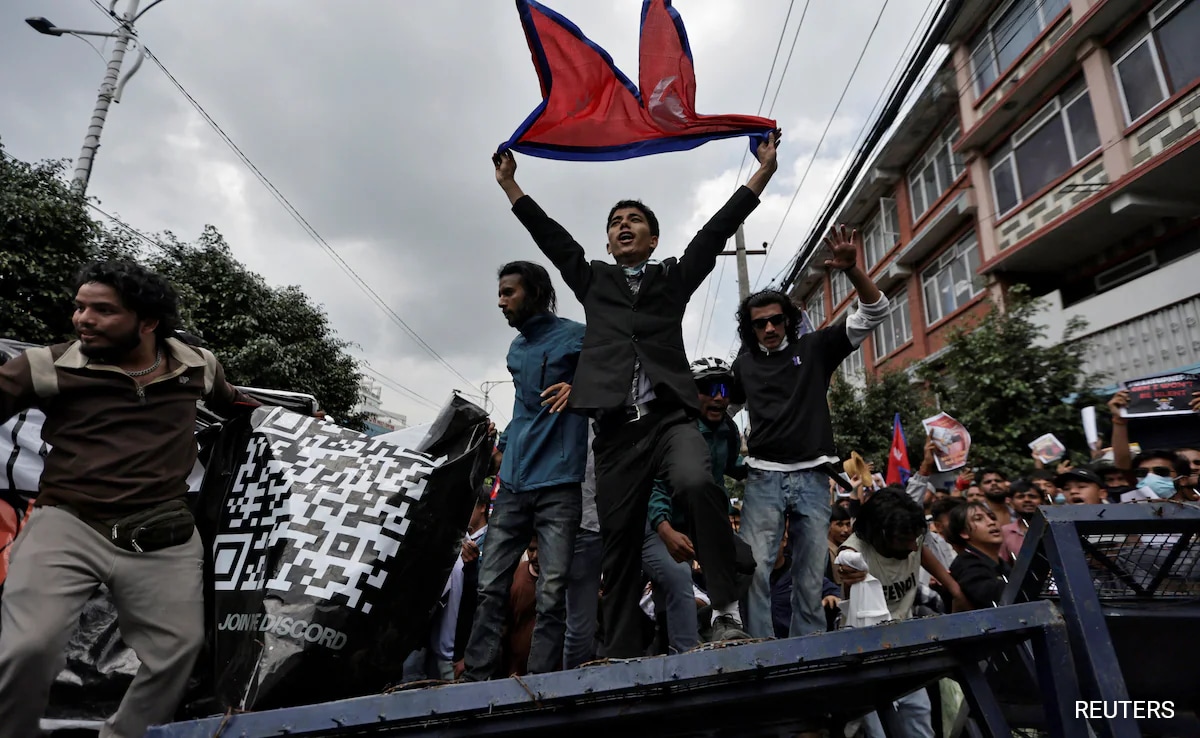Nepal in Turmoil: Gen Z-Led Protests Escalate, PM Oli Resigns After Violent Clashes
Gen Z Anger Boils Over in Nepal
Kathmandu, Sep 9 (TheTrendingPeople) — Nepal is witnessing one of its most dramatic political upheavals in recent years as Gen Z-led protests continue to sweep across the country. What began as a movement against corruption and a controversial social media ban has escalated into fierce demonstrations that forced Prime Minister KP Sharma Oli to resign late Tuesday, marking a turning point in the Himalayan nation’s political landscape.
Videos emerging from the capital, Kathmandu, show Finance Minister Bishnu Prasad Paudel, 65, chased by furious protesters through crowded streets. In one clip, a young protester leaps forward and kicks Paudel to the ground, sending him crashing against a red wall. The minister, visibly shaken but uninjured, quickly scrambles back to his feet and runs again before the video cuts off.
The shocking visuals have gone viral across unblocked platforms like TikTok, fueling further outrage and solidarity among young demonstrators demanding accountability from Nepal’s leadership.
PM Oli’s House Set on Fire, Cabinet Ministers Resign
Protesters also targeted Prime Minister Oli’s residence, setting parts of the house ablaze despite heavy police presence. The attack came just hours before Oli, who began his fourth term last year after striking a coalition deal with the Nepali Congress, announced his resignation under mounting pressure.
“I am stepping down because I cannot allow further bloodshed of our youth,” Oli said in a brief televised statement before leaving his residence. His resignation follows that of three other senior ministers who quit in the wake of Sunday’s violent crackdown that left at least 19 protesters dead — one of the deadliest government responses in recent years.
Police spokesman Shekhar Khanal confirmed that several groups had openly defied a government-imposed curfew. “There are cases of fire and attacks in many areas,” he told AFP, adding that security forces were struggling to contain the fast-moving protests.
From Social Media Ban to Street Revolution
The current unrest traces its roots back to Friday, when the Oli-led government abruptly cut access to 26 social media platforms, including Facebook, YouTube, and X (formerly Twitter), citing “unregistered operations” and “security risks.”
TikTok, however, remained accessible, and it became the digital backbone of the youth movement. Viral videos comparing the struggles of ordinary Nepalis with the lavish lifestyles of politicians’ children — flaunting luxury goods and foreign vacations — struck a chord with the country’s restless youth.
By Monday, thousands of students and young professionals poured into the streets demanding the restoration of social media and urgent action against corruption. Although the government repealed the ban on Monday night, the anger had already spilled over, transforming into a broader demand for systemic change.
The Youth Voice: “This is Our Future”
Many protesters see the movement as more than just a fight for digital freedom.
“This is our future at stake,” said 22-year-old activist Rojina Tamang outside Tribhuvan University in Kathmandu. “We are not just protesting a social media ban. We are standing up against corruption, inequality, and leaders who only care about themselves.”
Others echoed the sentiment, pointing out that Nepal’s leadership has failed to address joblessness and rising economic disparity. “We can’t find jobs here, but we see ministers’ children posting about their vacations in Dubai. That’s why we are in the streets,” said 19-year-old engineering student Prakash Gurung.
Timeline of the Protests
- Friday, Sept 5: Nepal government blocks access to 26 social media platforms, including Facebook and YouTube. TikTok remains active.
- Saturday, Sept 6: Viral TikTok videos expose growing inequality, sparking online outrage.
- Monday, Sept 8: Protests erupt across Kathmandu. Police clash with demonstrators, curfew imposed. Death toll rises to 19.
- Tuesday, Sept 9: Finance Minister Bishnu Prasad Paudel chased through Kathmandu. PM Oli’s residence set on fire. PM Oli announces resignation.
Implications for Nepal’s Political Future
The dramatic resignation of KP Sharma Oli raises questions about Nepal’s political stability. Oli, who had long been a dominant figure in Nepalese politics, leaves office under unprecedented pressure from the youngest demographic group in the country.
Political analysts say the protests mark a generational shift in Nepal’s democracy. “This is a movement led not by political parties, but by Gen Z,” said political commentator Meera Karki. “It reflects the frustrations of a generation that feels betrayed by the system and left out of the country’s economic progress.”
With Oli’s departure, attention now turns to the Nepali Congress and other coalition partners, who face the challenge of forming a caretaker government while addressing the demands of the protesters. International observers, including India and China, are closely watching developments in the Himalayan nation given its strategic geopolitical importance.
Final Thoughts from TheTrendingPeople.com
The events unfolding in Nepal highlight the power of youth-led movements in shaping political outcomes. What began as anger over digital censorship has transformed into a demand for sweeping reforms, signaling a generational awakening that the country’s leaders can no longer ignore.
As Nepal enters this uncertain chapter, the resilience and determination of its young protesters underscore a simple truth: in the digital age, silencing voices is nearly impossible. The world is watching as Gen Z in Nepal demands not only access to social media but also a government that listens, acts, and delivers on its promises.

